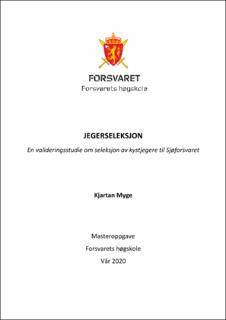JEGERSELEKSJON. En valideringsstudie om seleksjon av kystjegere til Sjøforsvaret
Master thesis
Permanent lenke
https://hdl.handle.net/11250/2683506Utgivelsesdato
2020Metadata
Vis full innførselSamlinger
- Masteroppgaver [466]
Sammendrag
I denne valideringsstudien undersøkes det hvilke variabler som har prediktiv validitet for hvilke kandidater som består kystjegerutdanningen. Utvalget (N = 139) omfatter alle kandidater som var preselektert og som møtte til opptak ved Forsvarets opptak og seleksjon (FOS) 2019.
Det ble anvendt prediktorer fra sesjon og FOS som tidligere er benyttet til seleksjon. I tillegg ble det tilført nye prediktorer i form av personlighetstrekk. Det ble gjennomført to tester; den norske militære personlighetstesten 5PFmil 2.0 og en norsk versjon av hardførhetstesten Dispositional Resilience Scale 15-R.
Kriteriet prediktorene ble målt opp mot var bestått kystjegerutdanning, hvor måloppnåelse ble skåret på en kontinuerlig skala. Det ble gjennomført en korrelasjonsanalyse og stegvis regresjonsanalyse for å undersøke prediktorenes prediktive validitet.
Regresjonsanalysen viste at sesjonsdata hadde ingen forklaringskraft (ΔR2 = .01, p = .931), mens de fysiske testene ved FOS hadde høyest prediktiv validitet (ΔR2 = .27, p = <.001). Personlighetstrekkene som ble gjennomført for dette kullet tilførte ytterligere forklaringskraft (ΔR2 = .10, p = .045). Til sammen ble 38 % av variansen i kriteriet forklart av modellen.
Studien anbefaler å se på løsninger som vil øke beslutningsgrunnlaget for hvilke kandidater som bør prioritertes ved opptak. Det anbefales å innføre egenrapportering innen personlighetstestene og fysiske tester, i forkant av preseleksjon av kandidater. Dette vurderes å kunne gi seleksjonsmaterialet betydelig økt kvalitet og kan gi flere effektiviseringsgevinster. The current study examines which variables that have a predictive validity when it comes to determining which candidates who will pass the Costal Ranger Qualification Training. The study sample (N = 139) consists of all candidates that were pre-selected and present during the Costal Ranger Assessment and Selection.
The study examined the existing predictors GMA, GPA and physical tests gathered from the conscript selection process, in addition to physical tests conducted during the Costal Ranger Assessment and Selection. Additional predictors were added based on the two personality tests; the Norwegian Military Personality Test 5PFmil 2.0 and the Norwegian version of the Dispositional Resilience Scale 15-R.
The criterion was pass or fail on the Costal Ranger Qualification Training, where the level of success was scored on a continuous scale depending when the drop out occurred in the process. A correlational analysis and a hierarchical multiple regression analysis were conducted in order to examine the predictors’ predictive validity.
The findings demonstrated that none of the predictors from the conscript selection process added validity in the regression analyses (ΔR2 = .01, p = .931), while the physical tests conducted during the Costal Ranger Assessment and Selection had the highest predictive validity (ΔR2 = .27, p = <.001). The personality traits conducted for this specific study contributed to incremental validity in the regression analyses (ΔR2 = .10, p = .045). In total, 38 % of the variance was explained by the model.
The study recommends potential solutions that may improve the decisions when it comes to which candidates that should be prioritized for the selection process. Furthermore, the study recommends an introduction of self-assessment in relation to personality traits and physical tests. This is believed to improve the selection, increase the quality of the candidates and result in several efficiency gains.
